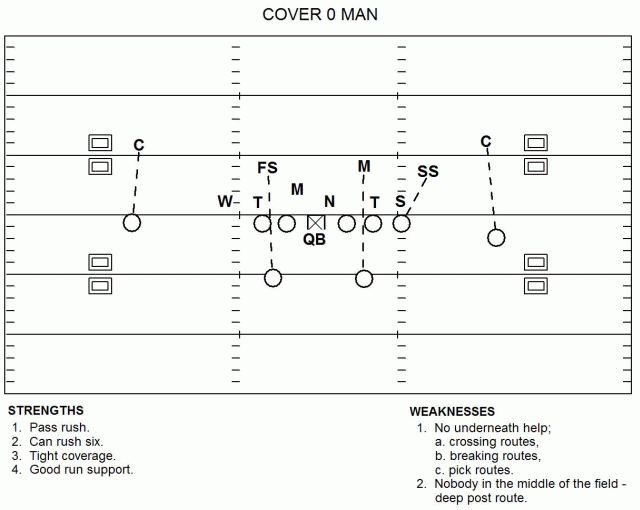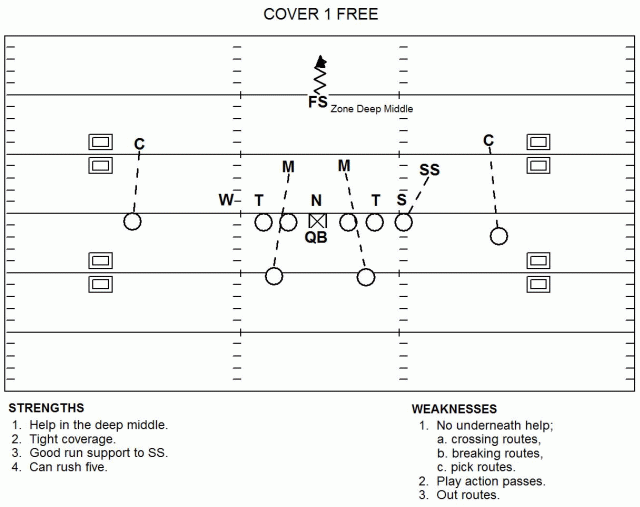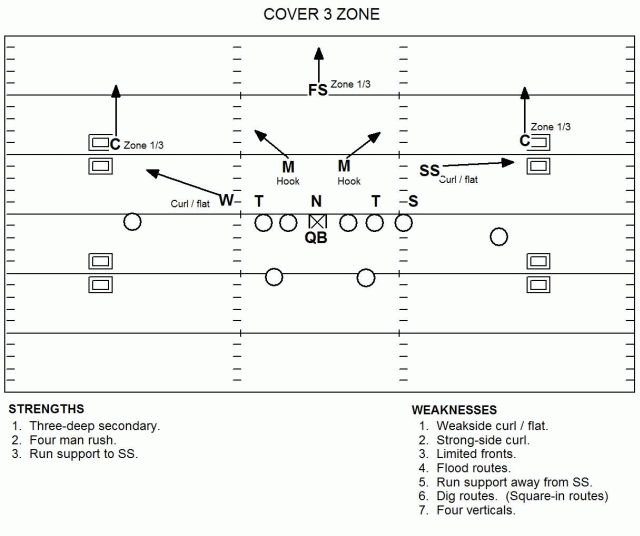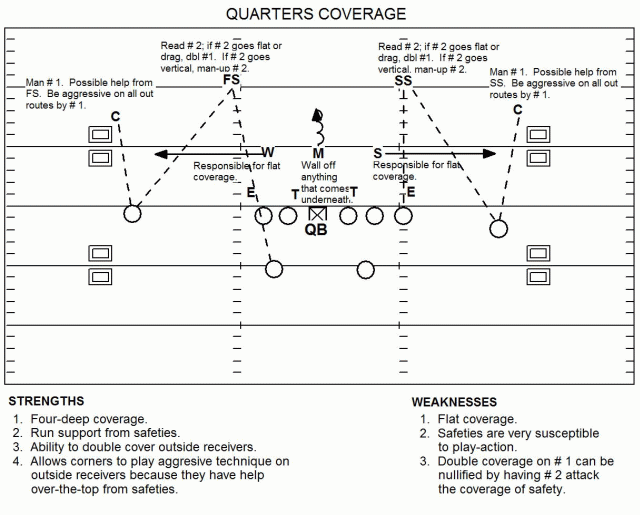|

Today
virtually every good high school QB coming into Division I football
can identify the differences between Cover 0,
1, 2, 3, 4 and the basic terminology mentioned below. Champion
Students are also educated and coached on various defensive schemes
beyond the following coverages.
The days of playing one primary defense in the secondary are long gone.
The reason is...if a defense plays too much of any one coverage
or look in the secondary whether it be man or zone, they know they
will eventually get burned as each coverage can be broken down and
dissected . Good coaching at the junior high, high school, and college
level will ensure that their Quarterback has a firm grasp and understanding
of the five (5) coverages below:

Cover 0 refers to pure man coverage with no deep defender/safety help. Cover 0
utilizes an extra rusher at the expense of deep coverage help leaving
each pass defender "on an island" with his man.
In cases like this the QB is going to look to get rid of the ball quickly
versus the rush. If protection holds up the offense often makes
a big play versus this defense. If not then the defense usually
gets in a good shot on the QB or at least forces a very rushed throw.


Cover 1 schemes include only one deep defender, usually a safety. Many underneath
coverages paired with Cover 1 shells are strictly man-to-man with
LBs and defensive backs each assigned a different offensive player
to cover. By using only one deep defender in Cover 1, the other
deep defender is free to blitz the quarterback or provide man-to-man
pass coverage help.
"1"
safety deep means there will be a single safety in the middle of
the field when the QB is under center and scanning the defense.
Generally the single safety will guard the deep middle of the field
on pass plays and in some cases he may to asked to provide some
double team support if there is a dominant WR in the game that needs
to be defended closely.


In traditional Cover 2
schemes the free safety (FS) and strong safety (SS) have deep responsibilities,
each guarding half (1/2) of the field. Cover 2 can be run from any
seven-man defensive fronts such as the 3-4 and the 4-3.
Teams
that play Cover 2 shells usually ascribe to the "bend-but-don't-break"
philosophy, preferring to keep offensive players in front of them
for short gains while limiting long passes. This is in stark contrast
to a more aggressive Cover 1 type scheme which leaves the offensive
team's wide receivers in single man-to-man coverage with only one
deep helper.
The
main weakness of the Cover 2 shell occurs in the middle of the field
between the safeties. The safeties attempt to gain width upon the
snap of the ball to cover any long passes to quick wide receivers
down the sideline. This movement creates a natural hole between
the safeties that can be attacked. By sending a receiver (usually
a tight end) into the hole, the offense forces the safety to make
a decision: play the vulnerable hole in the middle of the field
or help out on the wide receiver.
A
variation of Cover 2 is called the Tampa 2, where the middle linebacker
drops to the deep middle part of the field. The Tampa 2 requires
a quick middle linebacker who is capable of staying with tight ends
and wide receivers in pass coverage.


Cover 3 is
the other main form of "1" safety deep. Cover 3 is similar
to Cover 1 in that the QB will only see one safety deep in the middle
of the field. However it differs from Cover 1 in that it is a three
deep zone and not merely a single safety deep zone. Cover
3 refers to 3 deep defenders each guarding one-third (1/3) of the
deep part of the field. Cover 3 schemes are usually used to defend
against passes, mainly those towards the deep middle of the field.
The
main difference between Cover 1 and Cover 3 is that after the snap
the CB's will back off and not press the WR's at the line of scrimmage.


Cover 4 defense or "Quarters" coverage is the other main type of zone
defense in the "2" deep family. Cover 4 schemes are usually
used to defend against deep passes and is also referred to as 'prevent'
defense. Cover 4 is like Cover 2 in that two safeties are deep but
normally the two corner backs are playing off the line of scrimmage
as well. They can either line up tight and bail into this coverage
or line up off the WR and play loose the whole time. The concept
is simply to play a four deep zone across the back with the three
LB's playing a zone underneath. This strategy is used when the defense
is willing to sacrifice the short throw and stop deep passes on
instances like 3rd and 12 for example.

THERE IS A CHAMPION INSIDE EVERY ATHLETE©
|